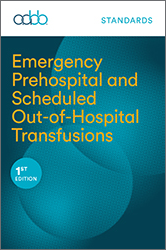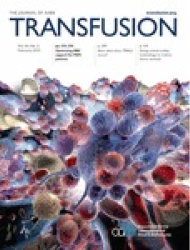
In response to increasing demand for blood transfusions administered in a prehospital or out-of-hospital setting, AABB recently released its first edition of Standards for Emergency Prehospital and Scheduled Out-of-Hospital Transfusions (EPSOHT Standards).1,2 This edition introduces new concepts for prehospital transfusions, while updating content from the Standards for Out-of-Hospital Transfusion Administration Services, released by AABB in 2018.
 “We have seen the use of blood products in the prehospital and out-of-hospital space increase in the last few years, and as these programs have begun to gain momentum, it was important to provide these groups with standards and guidance on how to maintain their programs,” said Audra L. Taylor, MS, SBB(ASCP), chair of AABB’s Prehospital and Out-Of-Hospital Standards Committee.
“We have seen the use of blood products in the prehospital and out-of-hospital space increase in the last few years, and as these programs have begun to gain momentum, it was important to provide these groups with standards and guidance on how to maintain their programs,” said Audra L. Taylor, MS, SBB(ASCP), chair of AABB’s Prehospital and Out-Of-Hospital Standards Committee.
The National Association of State Emergency Medical Services Officials (NASEMSO) Assessment estimates that there are approximately 18,200 local EMS agencies that respond to 9-1-1 calls for medical emergencies and injuries.3 However, fewer than 1% of these agencies have implemented prehospital blood transfusion, with the highest implementation rates in Texas, North Carolina and Virginia.4
For groups interested in implementing these programs, there is a lot of information to share, Taylor said. “People will reach out to a group that is already doing it and ask them to share standards of practice, or details of how it was set up,” she said. “With the new AABB standards, we wanted to make sure we are providing the right parameters for blood administration, as we do in our hospitals.”
The new standards include several notable updates. For example, in the out-of-hospital setting, the standards call for two ABO determinations to be performed. The first determination should be performed on a current sample and the second can occur by comparing to previous records, testing a second sample collected at a different time, or retesting.
For the prehospital setting, there is guidance outlining the use of uncrossmatched units of blood or blood components. “The standards do not require the EMS agencies to collect a sample for pretransfusion compatibility testing to be performed,” said Courtney Hopkins, DO, vice president, corporate medical director at Vitalant and a member of the AABB Prehospital and Out-Of-Hospital Standards Committee. “That is a shift from what we require for patients in the hospital setting and supports timely transfusions where conventional testing is not practical.”
Instead, the standards allow the designated transfusion administration service (TAS) medical director to determine appropriate ABO/Rh component selection and the maximum quantity of blood products that can be transfused. Taylor said that the specifics of how these decisions are made should be defined by each agency’s medical director.
“We are not telling them when or how much to give, they know the different patient triggers,” Taylor said. “Their training and experience will determine qualifying patients.”
Importantly, several sections of the standards address storage and transport for blood and blood components. “Blood storage is pretty standardized in hospitals, with some stored at room temperature, some refrigerated, and some frozen,” said Martin A. Schreiber, MD, who served on the AABB committee as a representative from the Trauma Center Association of America. “Here we created standards for how products are stored, with documentation of how long they have been stored in the prehospital and out-of-hospital setting.”
A high-level requirement calls for storage and transport in a “manner that prevents damage, limits deterioration and provides traceability.” Again, the specific protocols for how this is implemented and documented are left to the TAS.
According to Taylor, some of the most important standards outlined are those mandating that patient identification remains attached throughout transfusion.
“Making sure that the patient is identifiable is important throughout the continuum of care, as is being able to trace any units administered,” Taylor said. “This mandates that identification remains attached to the patient.”
Hopkins pointed out that this reinforces the need for the TAS to have clearly defined protocols in place. “It puts the responsibility on the EMS as the TAS,” she said.
Overall, the release of these standards reflects a move in the field to extend services to more areas, to standardize out-of-hospital and prehospital blood administration, and to ensure patient safety and procedural quality.
“There is a strong motivation throughout the nation to place blood products on ambulances so that they are immediately available to patients injured outside the hospital,” Schreiber said.
Indeed, Hopkins said that Vitalant is actively working on changing its program to align with these new AABB standards so that they can rapidly onboard new EMS agencies.
“We feel the need in this country to ensure blood is available in the prehospital setting,” Hopkins said. “Prior to the release of these standards, many EMS agencies faced significant challenges in safely administering transfusions, in part due to the absence of clear guidelines. Without clear guidance on storage, handling and documentation, it was difficult for blood centers to release units for use in ambulances or helicopters. These new standards provide a framework that supports safe, consistent practices, removing barriers and enabling more agencies to deliver lifesaving transfusions in the field.”
Now out-of-hospital locations or EMS agencies will have guidance on the proper storage and administration of blood products. Hopkins also mentioned that interested agencies should request financial support for AABB accreditation during grant funding.
There is still more work to be done to put these life-saving services into a higher percentage of EMS agencies throughout the country (see sidebar), but these guidelines are an important step in that process.
The EPSOHT Standards went into effect July 1 and will remain in effect for two years. Facilities and agencies interested in learning more about the standards may access a complimentary two-week trial in the AABB Store.
One of the barriers to greater availability of transfusion services through EMS agencies has been the cost of supplying blood and blood components, according to Martin A. Schreiber, MD, who served on the AABB committee as a representative from the Trauma Center Association of America.
“EMS services are part of the department of transportation and their primary purpose had been to get the patient from one place to another,” Schreiber said. “A transportation service can’t bill for providing care.”
However, in late 2024, the Centers for Medicare and Medicaid Services (CMS) modified the definition of Advanced Life Support, Level 2, adding administration of prehospital blood transfusion and including low-titer O-positive and O-negative whole blood transfusion therapy.
“This was the result of a tremendous lobbying effort, and now they can bill for these services,” Schreiber said. “The next important step is finding payers.”
Unfortunately, there was no new payment associated with this change. Resolving payment issues, either through CMS or commercial insurers, would go a long way to further implementation of prehospital transfusion services.
BACK TO ISSUE
August 2025
Transfusion is AABB’s scholarly, peer-reviewed monthly journal, publishing the latest on technological advances, clinical research and controversial issues related to transfusion medicine, blood banking, biotherapies and tissue transplantation. Access of Transfusion is free to all AABB members.
Learn More About Transfusion Journal
Keep abreast of what's happening in the field of biotherapies with CellSource - AABB's monthly update on the latest biotherapies news.
To submit news about the blood and biotherapies field to AABB, please email news@aabb.org.
President
Meghan Delaney, DO, MPH
Chief Executive Officer
Debra Ben Avram, FASAE, CAE
Chief Communications and Engagement Officer
Julia Zimmerman
Director of Marketing and Communications
Jay Lewis, MPH
Managing Editor
Kendra Y. Mims, MFA
Senior Communications Manager
Drew Case
AABB News
(ISSN 1523939X) is published monthly, except for the combined November/December issue for the members of AABB; 4550 Montgomery Avenue; Suite 700 North Tower; Bethesda, MD 20814.
AABB is an international, not-for-profit association representing individuals and institutions involved in transfusion medicine, cellular therapies and patient blood management. The association is committed to improving health by developing and delivering standards, accreditation and educational programs that focus on optimizing patient and donor care and safety.
+1.301.907.6977
Email: news@aabb.org
Website: www.aabb.org
Copyright 2025 by AABB.
Views and opinions expressed in AABB News are not necessarily endorsed by AABB unless expressly stated.
Notice to Copiers: Reproduction in whole or part is strictly prohibited unless written permission has been granted by the publisher. AABB members need not obtain prior permission if proper credit is given.
